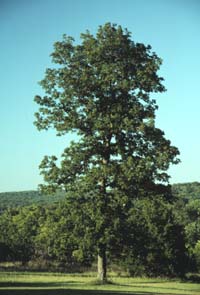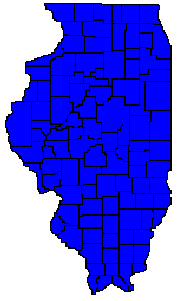 |
| Mockernut
Hickory (Carya tomentosa)
Distribution
Map to Right |

The mockernut hickory is also referred to as white hickory. It is a medium to tall tree (up to 90 feet in height) with a trunk of up to 3 feet in diameter. The crown is rounded and open. Mockernut hickory grows in dry upland forests in Illinois, mostly in the southern two thirds of the state.
Interesting
Facts
Hickories
may be divided into three groups, the pecans, the shagbarks, and the pignuts.
Mockernut, kingnut (or shellbark), and shagbark hickory comprise the shagbark
group. The shagbarks are distinguished from the pecan and pignut hickories
by their large terminal buds, thick twigs, and thick nut husks. The bark
of kingnut and shagbark hickories peels into long strips at maturity. This
trait is not shared by mockernut hickory, which has dark gray bark with
network of shallow ridges often in a diamond-shaped pattern. The species
name, tomentosa (Latin for hairy) is a reference to the hairy leaves.
Identifying Features
Bark
The bark is dark gray with an often diamond-shaped pattern of ridges.
Leaves
Mockernut hickory has yellow-green leaves that are hairy on the upper and lower surfaces. The leafstalks and twigs are also hairy. The leaves are alternate and pinnately compound. They are 8 to 20 inches long and have 5 to 9 lance-shaped leaflets, which are up to 8 inches long and about half as wide. Leaflets are pointed at the tip, rounded at the base, and have fine toothed edges. When crushed, the leaves are very fragrant. The bark is dark gray and shallowly ridged.
Flowers
Both male and female flowers appear on the tree as drooping clusters of catkins in early spring just as the leaves begin to unfold.
Fruits
The nuts are oval or round, approximately 2 inches in diameter, brown, and split to the base in 4 sections. The nuts ripen in September and October, are sweet and fragrant, and are eaten by wild game turkey, squirrels and other small mammals, as well as deer.
Uses
The wood
is coarse-grained, heavy, and strong. It is used for fence posts, tool
handles, fuel, and also as veneer, even though mockernut and the other
hickories are susceptible to a disease that causes the wood to split apart
at the annual rings. This splitting is a problem if the wood is used for
thin veneers. Native Americans used parts of the mockernut hickory to make
analgesics (pain relievers). The nuts were also a food source.